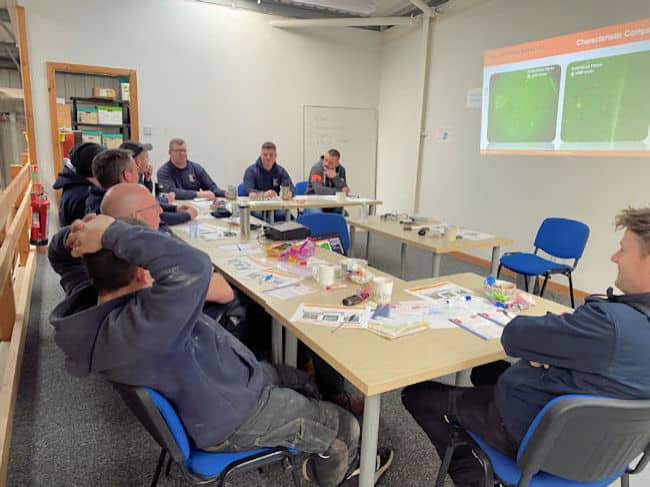Why be vigilant about hidden asbestos?
Almost any building work in older houses can expose you to asbestos fibres. This article is about the danger of asbestos in residential homes. It includes an example of how a family in Leeds were put at serious risk of harm, by an incompetent tradesman. Here is some simple advice to help you protect your family. Asbestos danger can arise during damp-proofing, structural work, and most home improvements.
Last week we hosted a full day of training for our surveyors and site technicians. These are the guys who visit residential and commercial premises every day. Surveyors specify essential damp proofing, or structural work, and our technicians complete it. An entire morning was dedicated to ‘Asbestos Awareness’
What many of our clients don’t realise, is that this sort of work, on older buildings, can reveal hidden asbestos. Asbestos in old textured coatings, or wall/ceiling boards.
Asbestos is a proven cause of lung cancer, and asbestosis, which is always fatal. The fine fibres are ultra small, and light, they can float in air for many hours, where they can be breathed-in and start work, destroying lung tissue. Mixed into old ‘artex’ type materials, and in boards, fibres are harmlessly bound under the surface. But if the material is removed by hand, or machine tools, it is pulverised, and the fibres are let loose.
Asbestos Awareness training is crucial for our team because it ensures they are competent to identify the risk of asbestos contamination. They are taught how to act safely when it is found or disturbed. We repeat this every year because it is so important.
If surveyors or technicians see any signs that asbestos containing materials (ACM’s) may be present, and scheduled for disturbance as part of our work, it is flagged-up’. Work is suspended to allow for testing, and if necessary, safe removal.
Hidden asbestos danger.
Unfortunately asbestos is sometimes hidden, and will only be revealed when it is exposed during a project. For example, old artex type finishes were very popular in the 20th century, with ceilings and walls covered in attractive swirls and patterns. It was a good alternative to heavily textured wood-chip or ‘anaglypta’ textured wallpapers. We now know that a proportion of these textured plasters contained asbestos. It cannot be checked without examination under high-magnification, so all coatings applied before the year 2000, are considered ‘at risk’.
When news of the danger first entered general knowledge, around 1990’s or so, stories spread that the cost of removal would always be many thousands of pounds. Homeowners were persuaded to avoid this problem by having the affected ceilings or walls ‘over-skimmed’, with fresh, smooth plaster. Once decorated, the buried asbestos was forgotten. On one level this was good advice, because asbestos is safe when encapsulated under new plaster. However, houses change hands and now, hazards are being created, as new owners set to work improving their space. They contaminate their lungs, during innocent restoration work.
But it is not only DIY enthusiast who can cause harm like this. A common scenario is having a builder visit to knock down a wall, or build an extension. A new kitchen, bathroom, or any electrical re-wiring, will also include hacking-off plaster, chasing through plaster, or drilling walls and ceilings. This is where the asbestos can escape, causing a danger to the contractor, their client, and an entire family.
A hazard avoided
Recently, Brick-tie Preservation were asked to install a damp-course and carry out specialist replastering in a home in Leeds. On arrival the technicians set to work, protecting floors and furnishings from dust and debris prior to hacking-off the old damp and salting plaster. However, when Darren (the supervisor on the site) cut a test sample of plaster from the wall, he found old textured plaster underneath it. Work was stopped and he made-safe the small patch, sealing it behind a temporary coat of PVA. Our client was informed. She was happy to wait for specialist testing to find out whether asbestos was present (you cannot tell by just looking at a sample). Darren placed a sign on the wall to warn of potential asbestos.

We had some work to do elsewhere in the property, so that work continued safely. We completed treating woodworm infestation in the roof and installing the chemical DPC in the external walls.
The test results were returned a day or two later and asbestos was confirmed (chrysotile). Therefore, we modified the scope of work to avoid disturbance of the material, keeping everyone safe, and still providing a dry wall surface for subsequent decoration.
Asbestos was released despite our efforts.
Unbeknown to us, our client had also scheduled other work in her new home. The electrician she had asked to re-wire the house had no asbestos awareness training. So only a few days later, after we had completed our work and left site, the electrician attended. He chased through many other walls in the house, installing new cable runs and ceiling lights. This was done with blind enthusiasm. Pulverised asbestos plaster was spread over floors in several rooms. The chap exposed himself to inhalation of asbestos fibres, contaminating the home, putting the health and lives of the entire family at risk. He contaminated his clothing, his vehicle (works van), and his own home. The hacked-off plaster went to general land-fill, rather than the the proscribed hazardous waste route. He went home happy, oblivious to the numerous criminal offences he had committed, and the hazard he caused.
Continual improvement
There was a lot of recrimination for the electrician, which is not our concern. However, we were upset on the clients behalf. We resolved to analyze our procedures, to see if they needed refining. It was discussed at our weekly de-brief, and at the next regular training day. We have strengthened our advice to clients. Our previous attention focused on how the problem of hidden asbestos could create hazards through our own activity. Now we’ve put more emphasis on follow-on trades, at residential sites. It’s clear lots of sole traders and micro-firms have no asbestos awareness (commercial sites tend to be more diligent). We place signage on the walls but this is strengthened now in an effortto engage the client directly, so they can protect themselves long after we’ve left.
This article is part of our effort to keep clients safe. It is digitally linked to the advice we supply to clients before work commences – as a written example of what can go wrong, when other contractors arrive on site.
Where asbestos is found or suspected, all clients are told – “You should inform ALL other trades who work here that we have identified potential asbestos containing material. They must include asbestos exposure in their risk assessments and work plans. Where we have identified ‘at risk’ materials, you should not disturb them. Tell other workmen who visit that the material cannot be disturbed, unless testing has shown it is asbestos free. If asbestos is found, and left in place, made-safe by encapsulation, you should make a written note of its location, and retain it for future reference”.
By law, contractors must carry out work on your home in a safe way. We shouldn’t need to tell them this, and neither should you. But sadly, health and safety standards are far too low, especially where smaller contractors and sole traders are concerned. We aim to build this reality into our systems, whenever we can.
Choose contractors carefully. It is not only about cost and availability. Professional contractors should be spending time and money to make sure they are abreast of health and safety regulations, and trends. Not just to tick boxes, but to keep you safe. Remember that health and safety evolves. It needs regular and persistent attention. Competence is not just about essential trade qualifications, it’s about safety, service, experience, and integrity.
It’s what we’re about.
You can find out more or book damp, timber or wall tie survey in Yorkshire, via our contact page. Our friendly and qualified team are here to help.
For basic additional information follow this useful link to the HSE website – Asbestos in the home (hse.gov.uk)


